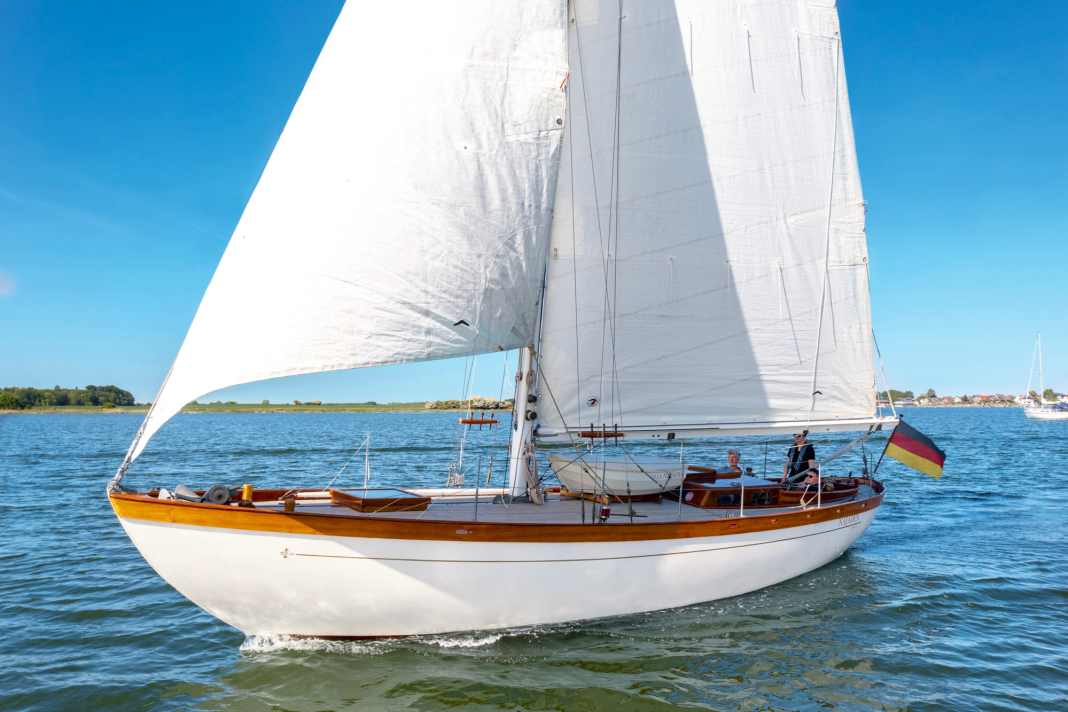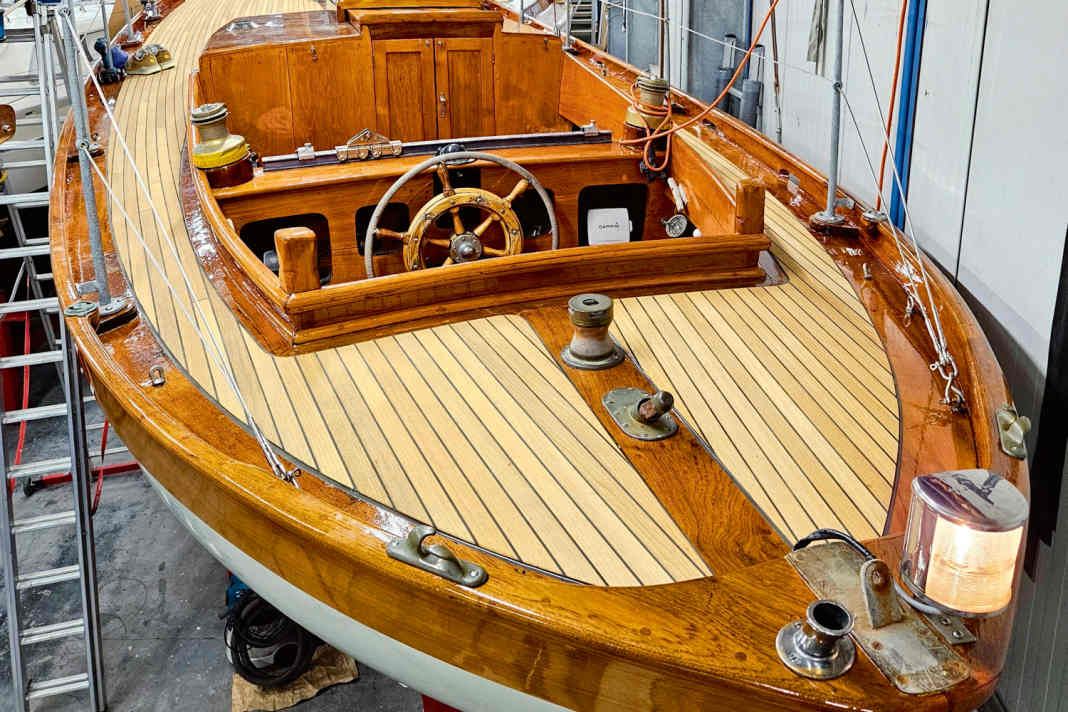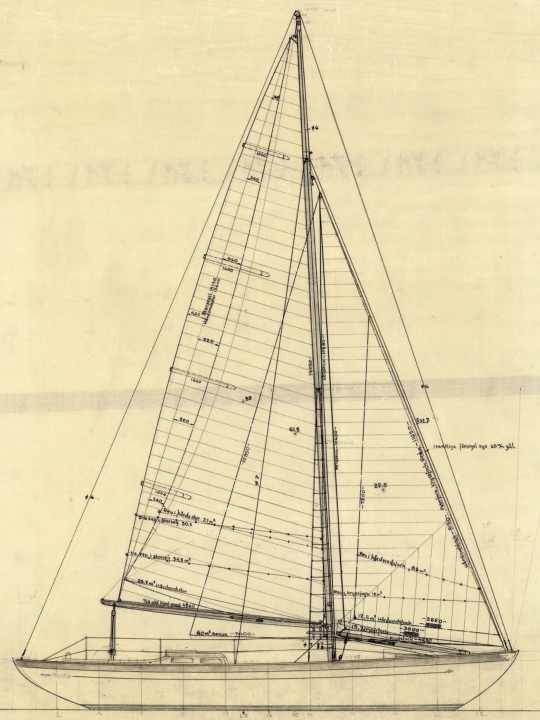





There are those owner couples that are not so common, where you quickly realise: they pull together, nothing can upset them so quickly, they tick in a similar way. Nicole and Andreas Schipper are one such couple. It goes without saying that you have to be an owner with a surname like that, but if you listen to them for a while when you first meet them on board and look into their shining eyes as they talk about their "Najaden", you realise that they are really passionate about their boat. When both of them can name the paintwork, work processes, timbers or whatever else at the drop of a hat, then it's close to a shared sailing paradise. No discussions about time-consuming winter work, expensive purchases or even too many sailing weekends in the summer. Nicole adds with a smile: "We always take it in turns to paint the individual surfaces for each course, so no one really knows who did it afterwards if a corner doesn't turn out perfectly." You have to come up with that first.
Other special boats:
The path to a classic Swedish pointed rig, a 12-metre Havkryssare, the Scandinavian counterpart to a German sea cruiser, did not seem so straightforward for the couple. They first met 16 years ago on a charter trip to Helgoland on a plain GRP ship from the large series.
And yet the beautiful classic cruising yacht is now moored in Maasholm harbour, because these were the sea cruisers or "Havskryssare" in Swedish. They were used for "cruising" when the term had not yet been taken up by the floating bed castles. At that time, cruising was synonymous with sailing. Not a Spartan survey or regatta class. Enough space below deck for a family. Reasonable galley and storage space. And yet reduced. The tiny cabin superstructure with wide running decks reveals that someone here had an eye for beautiful lines.
Masterpiece of tradition and elegance
"It was drawn by the Swede Åke Améen in 1948," says Andreas Schipper on board. It was an order for a Swedish wholesaler. It was built at the Rosättra shipyard near Stockholm, which still exists today and builds Linjett-GFK yachts, still known for their exceptional quality. Not many people in Germany are familiar with the designer of the ship, but in Sweden he is well known for his yachts. "We have even been approached by Swedes about our ship in the harbour."
A lot of work, but no total refit






It was a bit like today: the designers who won silver on the regatta courses, like his contemporary Knud Reimers, made the headlines and received a lot of attention. The cruising-orientated designers received less spotlight. However, their boats were no less successful or beautiful. Améen's boats were regarded as elegant, high-quality boats in Sweden. And the Slup with the pretty canoe stern is a beautiful example. The Swedish Maritime Museum still holds more than 500 documents such as sketches, detailed drawings and sail plans by the designer, including variants of the "Najaden" as a yawl or with a yacht stern.
The teak superstructure shines golden in the sun, the beautiful deck moulding lends elegance to the white hull and the new wooden deck looks immaculate. Bronze winches and fittings, manually operated anchor winch, no furling system, sea railing, but no bow and stern pulpit. Simple yet elegant.
"Naiads" finds its owners
But this is exactly how the two wanted it, as they explain in unison. "It is important to us that 'Najaden', named after a Norse goddess of waters and floods, remains close to the original designed by Améen. That's why we liked the fact that it hadn't been 'modernised' so much by the previous owners, i.e. no sprayhood, furling sails and the like had been retrofitted. Instead, it had reefable headsails on staysails. And this also meant that a bow and stern pulpit was fitted, which is not provided for in the crack. That's why we took them down again." The ship changed hands six times, including once to Norway. The most famous was probably the opera singer and later director of the Royal Opera in Stockholm, Set Svanholm. But how did the Schippers come to own such a beautiful and special ship?
"I did have a wooden folk boat many years ago, but when we met, I was travelling on GRP boats in charters or at regattas on the yachts of friends who owned them," says Andreas. Born in Oldenburg, he raves about the North Sea regattas, the Helgoland trips, the tours with an Optima 85, and holidays on the Baltic Sea so that the family can sleep in longer and not always be driven out of their berths by the merciless tide calendar. All of this has shaped his sailing DNA and also his professional life. Years ago, the master glazier specialised in all glass solutions for mega yachts, working with industry giants such as Lürssen.
From the Alster to the Spitzgatt sea cruiser
When the two met in 2012, Nicole's sailing experience was limited to dinghy sailing on the Alster in Hamburg in the university sailing group during her marketing studies. "My first real trip on a yacht was with Andreas to Helgoland. We had perfect weather, I liked the island, everything was just right." Less than a year later, the two were toying with the idea of buying their own boat.
"It was important to us that it was ready to sail. We didn't want a complete refit where the boat was torn apart first."
The budget of 25,000 euros set tight limits, so they searched not only in Germany but also in Scandinavia. They were open-minded; it could just as easily have been a steel or GRP yacht. And then they came across the "Najaden". Quite unromantically on the Internet, as is usually the case these days. But the photos aroused their curiosity.
"We travelled to Stockholm by car in September and we loved 'Najaden' straight away," they both say. Beautifully varnished teak superstructures, a solid mahogany hull, which Andreas poked wherever possible with a knife or screwdriver to check the wood. The harmonious pointed gate lines. It was also noticeable that the six previous owners had visibly looked after the boat well; there was no dramatic backlog of repairs as is so often the case with wooden boats that change hands frequently. If there is expensive damage, they are sometimes passed on like the proverbial hot potato. Not so with "Najaden".
"It is this and no other"
The last owner also makes a trustworthy impression, saying quite openly that there is a weak point at the bow that should be taken care of in the not too distant future. "It was very important to us that it was ready to sail. We didn't want a complete refit where the boat was completely torn apart and had to stay on land for two years, just working non-stop. It was clear to us: we want to sail it next summer!" says Nicole Schipper.
But they swore before the viewing that they wouldn't let the moment get the better of them if they liked the boat, and so they said goodbye to the owner, giving him a week to think about it. If someone beats them to it, so be it.
"And then, on the journey back, we were both silent in the car for the first 30 minutes. We both realised that it was her and no one else," recalls Andreas Schipper. Eventually they did talk. The two of them agonised over the time for a week, then they finalised the purchase. At the later handover and the Swedish owner's farewell to his boat, which he had to sell due to a move, he cried as they parted.
This is followed by the first mistake made by the new owner couple with the new old sea cruiser: they want to sail it directly to the new berth in Kiel in just a week or so. "That was sooo stupid of us!" says Nicole today, shaking her head. Under time pressure, they rush through beautiful archipelago landscapes that neither of them know yet - and encounter deserted harbours. In Sweden, the jetties are already folded up in September. They would have been better off putting it into winter storage on site and enjoying the crossing the following year to the full, says Nicole today.
Work on the boat is limited
However, this leaves time for an inventory during the winter on the Schlei. A boat builder expertly straightens the bow: 2.8 metres of stem need to be replaced, five floor cradles and nine bulkheads can no longer be saved. Nothing unusual for wooden boats that are around 70 years old. The repair had already been included in the purchase price together with the previous owner.
The two of them completely strip the hull, in which every third frame is made of steel, to get an impression of the remaining substance. However, the remaining mahogany planks and oak frames are rock solid. However, there are of course the usual traces of such ships with a composite structure of oak and steel frames: rust. At some point, the galvanisation will have gone through and the steel doesn't like the tannic acid in the oak, nor does the wood like the rust.
The keel bolts are replaced with new stainless steel ones. As a wooden boat owner, you have to consider that a few things come together over twelve years. But they pull it off as planned: The work will be spread over the next few years, not a brute feat that will overwhelm them both. There's just one thing they'll never get used to. "It's really nice to see people admiring our boat on the jetty, but the comment always comes back: 'But that would be too much work for me'," explains Nicole with a slight roll of her eyes.
Wedding on board the "Naiads"
At some point, the teak deck starts to leak and a first attempt to sand it down and reseal it fails due to the nails stuck vertically and horizontally in the teak. "That was a lesson. Just like the first winter with the boat outside. You just need an indoor space where you can work properly and boat builders who can do the really demanding work. After all, we are amateurs!" Otherwise, they do most of the work themselves: stripping all the wooden parts inside and out and applying twelve coats of new paint, for example. It's not just the boat and its owner who really get to know each other, they also grow together, and so after four years they decide to get married: Marriage on board! The heart project on the heart project, so to speak.
"Unfortunately, that didn't work out - the registry office in Hamburg wouldn't allow it!" regrets Nicole. Nevertheless, the ship is transferred from its berth in Heikendorf to Hamburg in keeping with its status, and at least the wedding photos are taken on board "Najaden", which has brought them so close together.
But now you want to feel a bit of the magic of the Nordic goddess, time for a test sail on the Schlei. Jib with staysailers, and the Nanni twin-cylinder with a full 15 hp and a boat weight of nine tonnes is already purring along nicely for the offshoot. Contemporary - at least back then. A real doldrums pusher. Outside, it's a classic approach to the mast, halyard winches with simple plug-in cranks and up with the main and jib. Of course, nothing has been redirected into the cockpit here; everything is driven directly on the white-painted 7/8 larch rig. The old goddess lies gracefully on her cheek and sets off.
Sustainable solutions for the classic sailing experience
Nicole stands at the back of the wheel in the cockpit, which is separated by the massive riding beam. Her gaze wanders over the unobstructed deck. It looks beautiful, like a teak deck, but it's not. "Despite all our love for classic boats, we believe that it is no longer ecologically appropriate to install a teak deck," explains Andreas. The alternative for them was Tesumo, a chemically resin-treated wood invented in Germany that was developed in collaboration with Lürssen, among others, as a teak alternative for the megayacht sector. Professionals in Kappeln carefully laid 18-millimetre-thick battens on a new plywood deck sealed with epoxy. Visually, this is very successful, a great alternative, even the grey tones are deceptively similar to those of an ageing teak deck. Time will tell how it performs over the years.
They travel up and down the Schlei in short strokes. This is helped by a small but very practical modernisation that the pair couldn't resist: They have swapped the genoa sheet winches with insertable single-lever operation for bronze, self-tailing models. They fit perfectly into the picture.
The home waters of "Najaden" and his crew are mainly the Danish waters, but the North Sea has also been on the itinerary time and again. Of course, there has also been a trip to Helgoland in the footsteps of their first sailing experience together.
Cruises in Scandinavia
For a while, we move from the crew cockpit in front of the riding beam to the helm. The rustic wooden wheel keeps the long keeler well on course, balanced, with no sign of the excessive rudder pressure that some boats with such a lateral plan have. Until the early 1950s, a tiller steering system was also fitted, the axle for which still protrudes from the aft deck. The tiller still exists, but the two of them love the wheel steering. We glide gently along the Schlei towards the green ringed beacon. What was the best trip and is there still a dream destination?
"Most of our tours take us around Funen or Zealand in Denmark. But we've been dreaming of the Åland Islands north of Stockholm for a while now." A short sabbatical should make it possible. After all, "Najaden" needs to return to the original waters that they only flew past back then.
Meanwhile, the oncoming crews repeatedly acknowledge the passing of the "Najaden" with a thumbs-up, shout "Nice ship!" and take photos of us. Even as a fellow sailor, it's a pleasure to receive such comments, the owners are beaming from ear to ear.
The power of the goddess.
Technical data of the "Naiads"

- Design: Åge Améen
- Shipyard: Rosättra Bådvarv (today Linjett)
- Year of construction: 1948 in Sweden
- Material: Mahogany hull on oak frames
- Superstructure and deck: Teak, today Tesumo
- LÜA: 11,95 m
- Width: 2,95 m
- Depth: 1,95 m
- Weight: 9 t
- sail area: 80 m²

